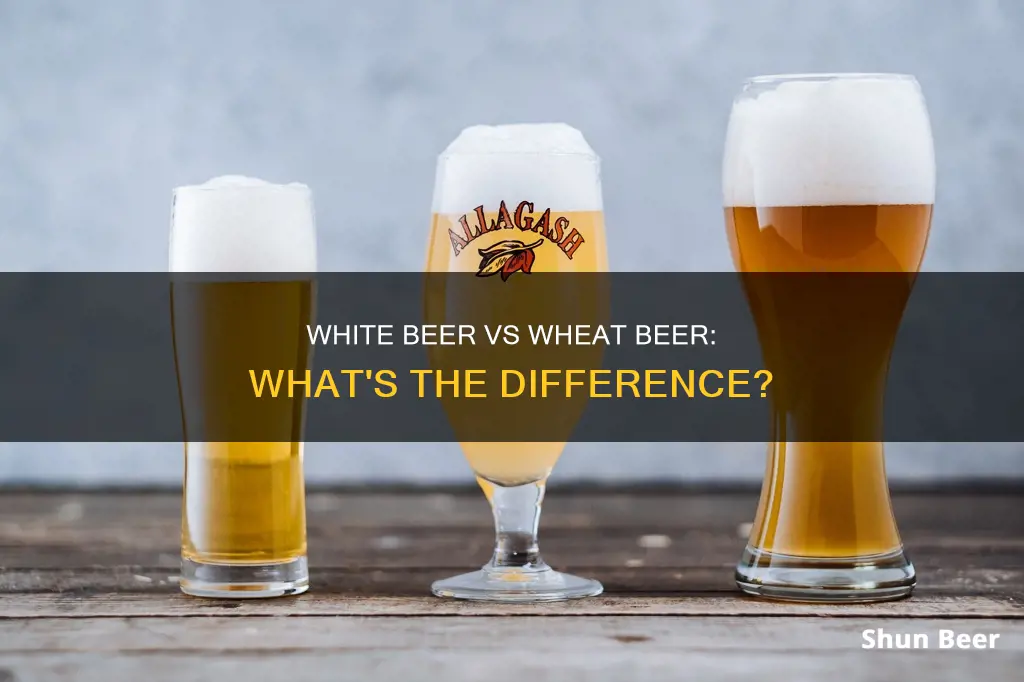
Wheat beer is a top-fermented beer with a large wheat-to-barley ratio. It comes in a variety of styles, including German Weizenbier and Belgian Witbier. Weißbier (German for white beer) is a type of wheat beer that uses at least 52% wheat to barley malt. Witbier (Dutch for white beer) is also a type of wheat beer, typically brewed with unmalted wheat and spiced with coriander and orange peel. So, is a white beer the same as a wheat beer?
| Characteristics | Values |
|---|---|
| Country of origin | Germany, Belgium |
| Main ingredients | Wheat, barley, hops, yeast |
| Appearance | Cloudy, white, pale, golden |
| Alcohol content | 4.0% to 7.0% ABV |
| Taste | Citrusy, spicy, fruity, bready, doughy, cracker-like |
| Carbonation | High |
What You'll Learn

German vs Belgian wheat beer
Wheat beer is a top-fermented beer brewed with a large proportion of wheat relative to the amount of malted barley. The two main varieties are German Weizenbier (or Hefeweizen) and Belgian Witbier (or Witbier).
German Wheat Beer
German wheat beer, or Weizenbier, is brewed with at least 52% wheat to barley malt. It is a light-coloured, top-fermenting beer. German wheat beer is brewed with special weizen yeast, which gives off characteristic clove and banana flavours. The Hefeweizen style is particularly noted for its low hop bitterness and relatively high carbonation. German wheat beer is traditionally served slightly warmer than its Belgian counterpart, at around 6-8°C, in a tall, narrow glass that flares outwards.
Belgian Wheat Beer
Belgian wheat beer, or Witbier, often contains less wheat than German wheat beer, which influences the overall taste profile. It is brewed with unmalted wheat, coriander seeds, curaçao peels (the peels of a bitter orange), and other spices. Belgian yeast offers additional fruity and spicy flavours. Witbier is best served between 3-5°C in a thick and sturdy glass.
New Glarus Beer: Wheat-Free or Not?
You may want to see also

ABV levels
ABV, or alcohol by volume, is a metric used to determine the alcohol content of a beverage. It is usually abbreviated and expressed as a percentage. The ABV of a drink will tell you how many ounces of alcohol are in the beverage. For example, a 12-ounce beer with 5% ABV contains 0.6 ounces of alcohol.
Beers typically fall in the 3.0% to 13.0% ABV range, with most being between 4.0% and 7.0% ABV. Some beers can be weaker or stronger than this. For example, low-alcohol beers like O'Doul's have 0.5% ABV, while some beers like the Eisbock style have ABV ranging from 9.0% to 15.0%.
White beers, which are a type of wheat beer, tend to have ABV levels between 4.5% and 5.0%. For example, the traditional Belgian-style white beer Hoegaarden has an ABV of 4.9%. The American brand Blue Moon, another popular white beer, has an ABV of 5.4%.
Stronger "grand cru" versions of white beer meant for holidays or special occasions usually have ABV levels between 8% and 10%. When well-brewed, these beers can be pleasantly balanced and expressive.
Wheat beers, in general, can have a wide range of ABV levels. Berliner Weiße, for instance, is a wheat beer with low ABV levels of 2.5% to 3.0%. On the other hand, Weizenbock, a wheat beer made in the bock style, tends to have a much higher alcohol content than other wheat beers.
Carlsberg Beer: Wheat-Free or Not?
You may want to see also

Ingredients
Wheat beer is a top-fermented beer brewed with a large proportion of wheat relative to the amount of malted barley. The wheat portion typically ranges from 30% to 70% of the total blend, with wheat extract malts usually consisting of 40% wheat and 60% barley. Wheat has more proteins than barley, contributing to long-lasting heads and haze, but it is also lighter in colour and contributes less flavour.
The two main varieties of wheat beer are German Weizenbier and Belgian Witbier. German Weizenbier, or Weißbier, is made with at least 52% wheat to barley malt, while Belgian Witbier, or Bière Blanche, uses raw unmalted wheat. Belgian Witbier is also known as "white beer" because it gets its name from the suspended yeast and wheat proteins, which cause the beer to look hazy or white when cold.
German Weizenbier is typically brewed with malted wheat, while Belgian Witbier uses raw unmalted wheat. Belgian Witbier also usually includes other grains such as oats or spelt, and is spiced with coriander and orange peel. Belgian Witbier is typically brewed with a Belgian ale yeast that produces unique fruity and spicy flavour notes.
Other types of wheat beer include Lambic (made with wild yeast), Berliner Weisse (a cloudy, sour beer), and Gose (a sour, salty beer).
Wheat Beer: Healthy Choice or Just Hype?
You may want to see also

Brewing processes
Wheat beers are brewed with a blend of wheat and barley, with the wheat portion anywhere from 30-70% of the total. Wheat extract malts are typically 40% wheat and 60% barley. Wheat is lighter in colour and contributes less flavour than barley, making it a great summer brew. Wheat beers are top-fermented and brewed with a large proportion of wheat relative to the amount of malted barley.
German Weizenbier and Belgian Witbier are the two main varieties of wheat beer. German Weizenbier is traditionally brewed with malted wheat, malted barley, and hops. German Weizenbier is also known as Hefeweizen, and is often unfiltered. It is noted for its low hop bitterness and relatively high carbonation. German Weizenbier is also available in darker varieties, such as Dunkelweizen and Weizenbock.
Belgian Witbier, or white beer, is an unfiltered, top-fermented wheat beer. It is often made with raw, unmalted wheat, as well as spices such as coriander and orange peel. Belgian Witbier is typically brewed with a special yeast that ferments with a little crisp tartness. It is also known as bière blanche in French.
The brewing process for Belgian Witbier involves steeping grains in a muslin bag in 2 gallons of hot water (about 160 degrees) for 20 minutes. After removing and discarding the grain bags, stir in the malt extracts, turn the heat back on, and bring to a boil. Add the bittering hops and boil for an hour, then add the flavour and/or aroma hops at the end of the boil. Cool the wort down, then pitch the yeast.
The brewing process for German Weizenbier is similar, but with some key differences. First, steep the grains in a muslin bag in 2 gallons of hot water (160 degrees) for 20 minutes. Remove and discard the grain bags, then stir in the malt extracts. Return to heat and bring to a boil. Add the hops and boil for 60 minutes. Put 3 gallons of very cold water into a fermenter, then pour in the hot wort. Cool below 80 degrees, then pitch the yeast, attach the cover, and attach an air lock. Ferment until the final gravity remains constant for 2-3 days, then bottle.
Wheat Beer: What's the Deal?
You may want to see also

Taste and appearance
Wheat beer is a top-fermented beer brewed with a large proportion of wheat relative to malted barley. The two main varieties are German Weizenbier and Belgian witbier. German Weizenbier, or Weißbier, is a light-coloured beer that uses at least 52% wheat to barley malt. It is known for its low hop bitterness and relatively high carbonation. The flavour profile includes notes of banana, clove, bubble gum, and vanilla.
Belgian witbier, on the other hand, is brewed mainly in Belgium and the Netherlands. It is a barley/wheat, top-fermented beer that gets its name from the suspended yeast and wheat proteins, which give it a hazy, white appearance when cold. Along with hops, it is typically flavoured with coriander, orange, and bitter orange. It has a somewhat sour taste due to the presence of lactic acid or acetic acid.
Traditional Belgian-style white beer is made with malted barley and unmalted wheat, resulting in a very pale yellow colour with a slight haziness and a rich, foamy head. The taste is slightly tart, balanced with light malt and wheat flavours, and enhanced with complex citrus and spice notes. The alcohol content of traditional white beer is between 4.5% and 5.0% ABV.
Unmalted wheat is challenging to work with, so some brewers have created their own versions of Belgian white beer. One popular example is Blue Moon, which is spiced with coriander and Valencia orange peel. It has a cloudy gold appearance and a medium body with an overall orange-citrusy flavour and aroma. The alcohol content is slightly higher at 5.4% ABV.
In summary, while both German Weizenbier and Belgian witbier are classified as wheat beers, they differ in their flavour profiles, appearance, and production techniques. German Weizenbier has a lighter colour and features notes of banana and clove, while Belgian witbier is hazy and white, with coriander and orange flavours. Traditional Belgian-style white beer has a slightly tart taste and a pale yellow hue, while variations like Blue Moon showcase a cloudy gold appearance with enhanced citrus characteristics.
Crawford Bock Beer: Is It Wheat-Based?
You may want to see also
Frequently asked questions
White beer, or "witbier" in Dutch, is a type of wheat beer. It is typically brewed with a mix of pale barley malt, unmalted wheat, and sometimes oats, which gives it a creamy mouthfeel. It is often spiced with coriander and citrus notes and has a distinctive bready flavour.
Wheat beer is a category of beer that originated in Bavaria. It is typically a top-fermented ale and uses at least 30% wheat in the brewing process. Wheat beers are usually light in colour, low to medium in alcohol content, and can be cloudy or clear in appearance.
No, they are not the same, but they are related. White beer is a type of wheat beer. However, there are some key differences between the two styles. For example, witbiers are made with unmalted wheat, while wheat beers are made with malted wheat. Witbiers also contain less wheat than wheat beers, which influences the overall taste profile.
Some popular white beers include Hoegaarden Witbier, Allagash White, and Blue Moon Belgian White. Notable wheat beers include Paulaner Hefeweizen, Weihenstephaner Hefeweissbier, and Franziskaner Weissbier.







